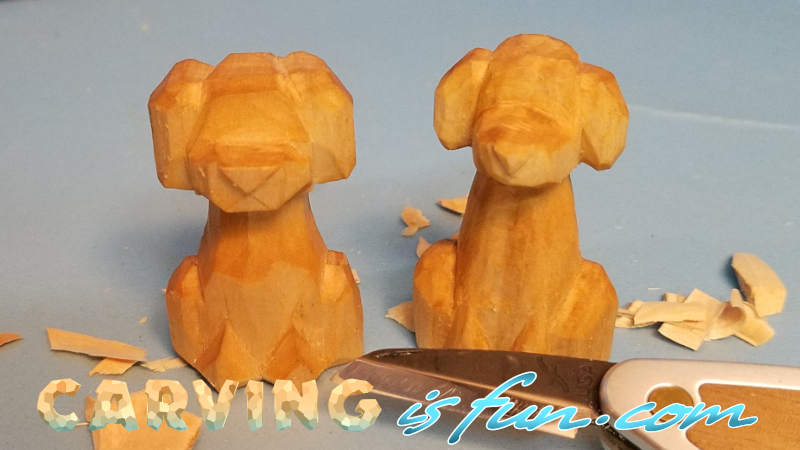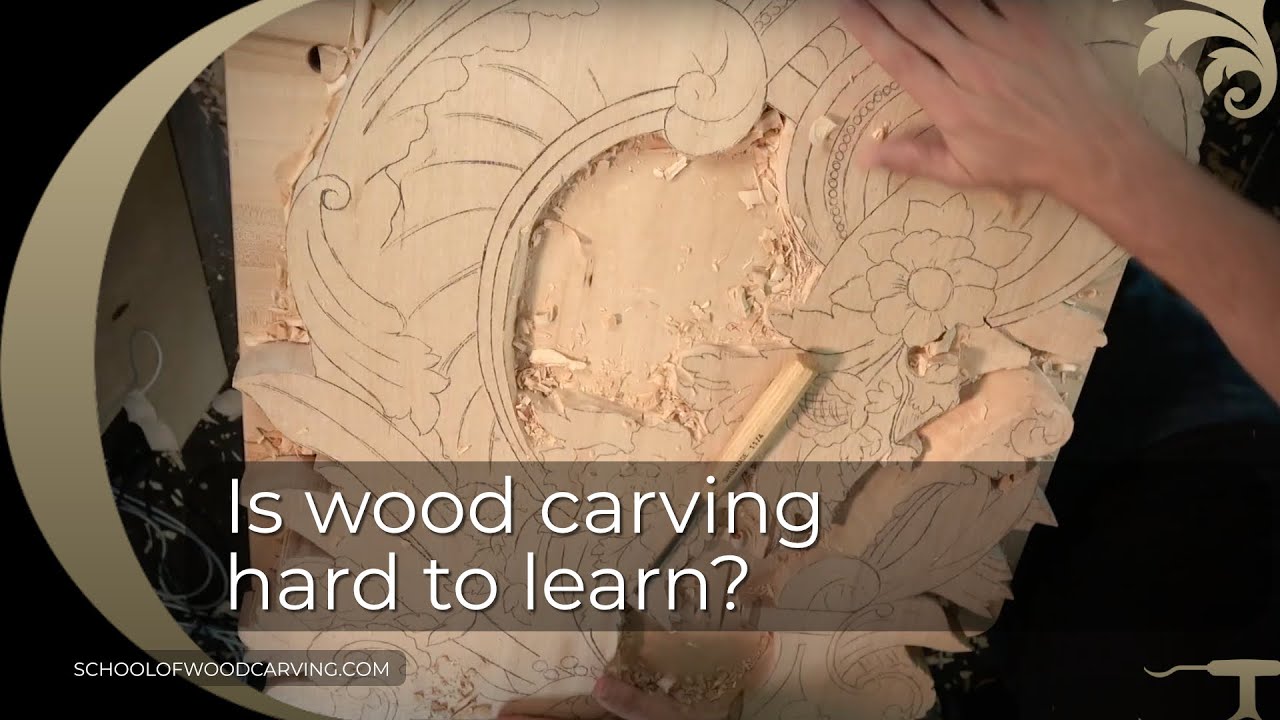So you’ve heard about wood carving and you’re wondering, “How hard is wood carving?” Well, let me tell you, it’s a fascinating craft that requires both skill and patience. In fact, wood carving is a unique art form that has been practiced for centuries around the world.
Wood carving involves shaping wood into beautiful sculptures, intricate designs, or even functional objects. It requires using various tools such as chisels, gouges, and knives to remove layers of wood and create intricate details. But don’t worry, it’s not as intimidating as it might sound!
Wood carving can be as easy or as challenging as you want it to be. If you’re just starting out, you can begin with simple projects and gradually move on to more complex designs as you gain experience and confidence. With practice and dedication, you’ll be amazed at what you can create with a block of wood and a few carving tools. So, are you ready to unleash your creativity and embark on a wood carving journey? Let’s dive in!

How Hard Is Wood Carving?
Wood carving is a traditional craft that requires skill, patience, and attention to detail. Many people are intrigued by the art of transforming a simple piece of wood into a beautiful sculpture or decorative item. If you’re wondering how hard wood carving really is, this article will provide you with in-depth information and insights into the challenges and rewards of this craft.
1. The Learning Curve
Wood carving can be both challenging and rewarding, but the learning curve can vary depending on various factors, such as your artistic aptitude, hand-eye coordination, and previous experience with woodworking. For beginners, the initial stages of wood carving can feel daunting as you navigate the tools, techniques, and materials. However, with dedicated practice and a willingness to learn, you can gradually develop your skills and gain confidence.
When starting out, it’s essential to begin with simple projects and gradually progress to more complex designs. This allows you to understand the basic techniques and develop your ability to visualize and execute designs on wood. Taking classes or workshops with experienced wood carvers can also provide invaluable guidance and mentorship during the early stages of your wood carving journey.
Remember that wood carving is a skill that takes time and effort to master. Patience and persistence are key attributes that will serve you well on your carving journey. With time, you’ll find that what once seemed difficult becomes more natural and enjoyable as your skills progress.
2. Tools and Techniques
Another factor that can influence the difficulty of wood carving is the choice of tools and techniques. Wood carving utilizes a variety of cutting tools, such as chisels, gouges, and knives, each serving a specific purpose. The mastery of these tools and understanding their safe usage is crucial for both effective carving and your safety.
There are different techniques employed in wood carving, including relief carving, chip carving, and carving in the round. Each technique requires a different skill set and level of precision. For example, relief carving involves carving away the background material to create a three-dimensional design, while chip carving involves the removal of small chips from the wood’s surface to create patterns and textures.
As you gain experience and familiarity with different tools and techniques, you’ll be able to tackle more intricate projects and challenge yourself creatively. Experimenting with different tools and techniques can also help you discover your own unique style and approach to wood carving.
3. Time and Dedication
Wood carving is a craft that demands time and dedication. The intricacy and detail involved in creating a wood carving piece can make the process time-consuming. A single project can take hours, days, or even weeks to complete, depending on its complexity and size. It’s important to have realistic expectations regarding the time commitment required for wood carving.
To succeed in wood carving, you need to be dedicated and committed to honing your skills. Regular practice is essential to build muscle memory, refine techniques, and develop your artistic sensibilities. Carving consistently and setting aside dedicated time for your craft will help you progress and improve.
While the journey of wood carving can be challenging, the rewards are abundant. The satisfaction of creating something beautiful with your hands, the therapeutic benefits of working with wood, and the sense of accomplishment when you complete a project are some of the rewards that come with wood carving. With perseverance and a passion for the craft, wood carving can provide a fulfilling creative pursuit.
Additional Persian H3 Headings
4. Essential Wood Carving Tips for Beginners
5. The Benefits of Wood Carving
6. Wood Carving vs. Other Art Forms
7. Choosing the Right Wood for Carving
4. Essential Wood Carving Tips for Beginners
For beginners starting their wood carving journey, it’s important to keep a few essential tips in mind. These tips can help you navigate the initial challenges and set a strong foundation for your carving practice. Here are some tips to help you get started:
1. Start with Softwoods
As a beginner, it is recommended to start carving with softwoods such as pine or basswood. These woods are easier to work with and carve compared to hardwoods, allowing you to focus on developing your skills without excessive resistance from the wood grain.
2. Invest in Quality Tools
Investing in good quality carving tools is crucial for a rewarding carving experience. High-quality tools will not only provide better results but also last longer and offer greater control during carving. Start with a basic set of tools, including a chisel, gouge, and carving knife, and gradually expand your collection as your skills progress.
3. Practice Basic Techniques
Mastering the basic carving techniques is essential for any wood carver. Start by learning foundational techniques like push cutting, pull cutting, and stop cuts. These techniques will help you achieve a variety of carving effects and build a strong technical foundation for more complex projects.
4. Take Breaks and Rest
Wood carving requires intense focus and concentration. It’s important to take regular breaks and rest your hands to prevent fatigue and reduce the risk of injury. Give your muscles and joints time to recover, and return to carving with renewed energy and precision.
5. Embrace Mistakes as Learning Opportunities
As a beginner, it’s natural to make mistakes while carving. Rather than being discouraged, embrace mistakes as learning opportunities. Analyze where you went wrong and use it as a chance to improve your technique. Mistakes can lead to unique discoveries and help you develop your own style as a wood carver.
6. Seek Inspiration and Learn from Others
Don’t be afraid to seek inspiration from other wood carvers and learn from their work. Attend workshops, join carving communities, and engage with experienced carvers. Connecting with fellow carvers can provide valuable guidance, inspiration, and support as you progress in your wood carving journey.
7. Enjoy the Process
Wood carving is not just about the end result; it’s about enjoying the process. Embrace the meditative quality of wood carving and let the creative energy flow. Take pleasure in each carve, each stroke, and the transformation of a piece of wood into a unique masterpiece. Enjoying the process will deepen your connection with the craft and keep you motivated to continue carving.
Key Takeaways: How Hard is Wood Carving?
- Wood carving can be challenging but also rewarding.
- It requires patience, practice, and a steady hand.
- Starting with simple projects helps build skills gradually.
- Using the right tools and techniques makes the process easier.
- With dedication and time, anyone can learn and enjoy wood carving.
Frequently Asked Questions
Curious about the difficulty of wood carving? We’ve got answers to your burning questions!
What skills do I need to start wood carving?
Wood carving does require some skill, but it’s not impossible to learn. Patience is key, as carving requires steady hands and attention to detail. Basic knowledge of different carving techniques and tools, such as gouges and chisels, is helpful. However, with practice, dedication, and the right resources, anyone can start wood carving.
There are plenty of beginner-friendly tutorials, workshops, and online courses that can teach you the fundamentals of wood carving. Start with simple projects and gradually build your skills. Remember, even experienced carvers were beginners once, so don’t be discouraged. With time and practice, you’ll be able to create intricate and beautiful wood carvings.
What are the challenges of wood carving?
Wood carving can be both rewarding and challenging. One of the main challenges is the physical effort involved. Carving requires both strength and precision, as you’ll be using tools to remove material from the wood. This can be physically tiring, especially when working on larger projects.
Another challenge is mastering the techniques and achieving the desired level of fine detail. It takes time to develop the necessary skills and hand-eye coordination required for intricate carving. However, with practice and persistence, you’ll refine your techniques and overcome these challenges, ultimately becoming a skilled wood carver.
Is wood carving suitable for beginners?
Absolutely! Wood carving is accessible to beginners. While it may seem daunting at first, starting with simple projects and gradually progressing to more complex ones is a great way to learn. Begin by practicing basic carving techniques and getting to know your tools.
There are also many resources available, such as books, instructional videos, and online communities, that can provide guidance and inspiration for beginners. Don’t be afraid to seek out these resources to enhance your learning experience. With passion and commitment, you can definitely become a proficient wood carver, regardless of your skill level.
What tools do I need to get started with wood carving?
To get started with wood carving, you’ll need a few essential tools. Some common tools include carving knives, gouges, chisels, and a mallet. These tools help you shape and remove material from the wood.
It’s advisable to start with a basic set of tools and gradually expand your collection as you progress. Quality tools are essential, as they provide better control and safety. Look for tools that are suitable for your skill level and the type of carving you want to do. Don’t forget the importance of safety equipment, such as gloves and eye protection, to ensure a safe carving experience.
How long does it take to become proficient in wood carving?
Becoming proficient in wood carving is a journey that varies for each individual. The learning curve depends on factors such as the amount of time you dedicate to practice, your natural aptitude, and the complexity of the projects you undertake.
While you can create simple wood carvings relatively quickly, mastering the intricate details and advanced techniques takes time and practice. It’s recommended to start with small, achievable projects and gradually increase the difficulty level as you improve. Remember, consistency is key. By dedicating regular time to practice and challenging yourself, you’ll progress faster and become a skilled wood carver in due course.

Wood Too Hard to Carve? Try This!
Summary
So, to sum it up, wood carving can be challenging, but with practice and patience, anyone can learn. It requires some specific tools and techniques, but it’s a rewarding and creative hobby. It’s important to start with simple projects and gradually progress to more complex ones. Remember to take breaks and not rush the process. Enjoy the satisfaction of bringing life to a piece of wood through carving!
In conclusion, wood carving may seem hard at first, but with determination and the right guidance, it can become an enjoyable and fulfilling skill. So, don’t be afraid to give it a try and discover the joy of transforming a plain piece of wood into a work of art!
